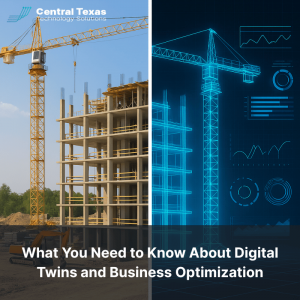
 Technology is evolving fast, and if your business isn't leveraging it, you're already behind. One innovation that’s quietly revolutionizing the way organizations run is digital twin technology. It’s no longer just for large enterprises or manufacturing plants. Today, digital twins are transforming how businesses of all sizes, including those in healthcare, law, construction, and more, optimize operations, reduce risks, and make data-driven decisions with confidence.
Technology is evolving fast, and if your business isn't leveraging it, you're already behind. One innovation that’s quietly revolutionizing the way organizations run is digital twin technology. It’s no longer just for large enterprises or manufacturing plants. Today, digital twins are transforming how businesses of all sizes, including those in healthcare, law, construction, and more, optimize operations, reduce risks, and make data-driven decisions with confidence.
If you're looking for a smarter way to streamline your business, improve safety, and plan for the future, it’s time to take a closer look at digital twins.
What Are Digital Twins?
At its core, a digital twin is a virtual model that mirrors real-world processes, workflows, assets, or even entire business systems. Think of it as a dynamic, data-driven replica of your operations—constantly learning, adjusting, and guiding your decisions in real time.
Here’s how digital twin technology works:
- Data Collection: IoT sensors and connected devices gather real-time data from your physical operations.
- Data Processing: That raw data is cleaned, organized, and fed into a simulation engine.
- Simulation: AI and analytics tools identify patterns, trends, and performance issues.
- Refinement: You make adjustments based on insights, test again, and repeat the cycle, continually improving the accuracy and value of the digital twin.
This isn’t guesswork. It’s intelligent modeling that lets you experiment and optimize without real-world risks.
Why Businesses Are Turning to Digital Twins
Organizations in Central Texas and beyond are embracing digital twins because they enable more agile, efficient, and predictable operations. Here’s what that looks like in practice:
Predictive Maintenance That Prevents Downtime
Downtime isn’t just inconvenient—it’s expensive. Digital twins monitor equipment health in real time and flag issues before they become costly problems. With predictive maintenance, you can:
- Anticipate system failures before they happen
- Minimize disruptions to productivity
- Extend the lifespan of your equipment
Smarter Product Development
Launching a new product or service? Don’t wait until it hits the market to discover flaws. Digital twins let you:
- Test prototypes virtually before building
- Spot design flaws early in development
- Accelerate time to market with fewer surprises
Operational Efficiency at a Whole New Level
Whether it’s manual data entry or inefficient routing, digital twins shine a light on what’s dragging your business down. With detailed process simulations, you can:
- Identify bottlenecks in real-time workflows
- Improve scheduling and resource allocation
- Reduce waste and increase throughput
Safer Work Environments Through Simulation
Construction firms, healthcare providers, and manufacturers often face dangerous working conditions. With a digital twin, you can:
- Simulate emergency scenarios without putting anyone at risk
- Test compliance with OSHA or industry-specific standards
- Train employees more effectively on safety protocols
How to Introduce Digital Twins Into Your Business
Rolling out digital twins doesn’t have to be overwhelming. Here’s a practical approach:
- Start small: Focus on a single area like fleet logistics, HVAC monitoring, or inventory management.
- Trial and evaluate: Run a pilot program and gather internal feedback.
- Plan to scale: Once proven, expand the model to other departments or facilities.
- Assess resources: Determine whether your internal team can support development or if an outside IT partner is needed.
Success comes from a phased rollout that prioritizes low-risk experimentation, cross-team collaboration, and continuous improvement.
FAQ: Digital Twins and Your Business
1. Are digital twins only useful for large companies or manufacturers?
Not at all. Businesses of all sizes—from nonprofits and healthcare providers to legal firms—can benefit from improved decision-making, resource efficiency, and risk management.
2. What kind of technology do I need to get started with digital twins?
At a minimum, you’ll need IoT sensors, cloud computing resources, and access to analytics software. Many businesses work with IT providers to streamline the setup and integration process.
3. How long does it take to see ROI from a digital twin implementation?
Most organizations begin seeing measurable improvements in efficiency and cost savings within a few months of their pilot program, especially when focused on high-impact areas.
Ready to explore how digital twins can optimize your operations? CTTS can help you evaluate, implement, and scale the right solution for your business.
Contact CTTS today for IT support and managed services in Austin, TX. Let us handle your IT so you can focus on growing your business. Visit CTTSonline.com or call us at (512) 388-5559 to get started!
